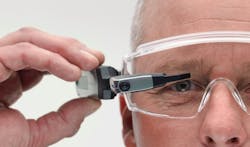Olympus introduces smart glasses for use in the enterprise
Olympus America (Center Valley, PA) has commercially launched (in the United States only, at first) a pair of smart glasses called the EyeTrek INSIGHT EI-10. The device is intended mainly for use in the enterprise; examples on the Olympus website include use at warehouses, such as for instant reading of QR codes (2D barcodes). This area of application is similar to that for the famed (and infamous) Google Glass, first introduced by Google for consumer use; after an initial negative reaction by consumers partly due to the inclusion of a camera, the Google Glass has found some success in the enterprise. (The EI-10 also has a camera, which has a resolution of 1992 x 1216 pixels.) Olympus has reason for introducing its new glasses: smart glasses introduced by other manufacturers have at least in some cases surpassed Google Glass for enterprise use.
Pupil division optics
The EI-10 does not use a beamsplitter to overlay its screen on the user's vision field; instead, it uses "pupil division," which diverts part of the light passing through the pupil plane (from the eye) to the device's screen. In practice, a very small probe sticks out into the field of view, but is very much out of focus and, although appearing large, also appears relatively transparent, allowing the viewer to see the outside world. However, the projected OLED screen, which has a resolution of 640 x 400 pixels, is sharply in focus with a field of view of about 13°.
The 66 g device, which incorporates both wireless LAN and Bluetooth technology for wireless connection to a network or to peripheral devices, is equipped with an attachment mechanism that allows it to be mounted to safety glasses or prescription glasses. Embedded sensors allow for navigation of the user interface and applications, which include photo and video capture and playback, a QR code reader, and utility functions for customized applications. User input is achieved via a touch area toward the rear of the device.
The EI-10 is equipped with the Android operating system, and Olympus supplies software-development tools to create custom apps.
Partners including Rochester Optical have worked with Olympus to develop prescription eyeglass frames with an integrated EI-10 mounting mechanism. WESTUNITIS, a Japan-based software company, provides business software for use with the EI-10. Olympus is seeking more businees partners for the EI-10.
The device is available starting November, 2017 for an estimated street price of $1,499.99 USD.
For more info, see www.getolympus.com/smartglasses.
Additional source: https://www.prnewswire.com/news-releases/olympus-launches-the-eyetrek-insight-ei-10-smart-glasses-for-business-applications-300550021.html
About the Author
John Wallace
Senior Technical Editor (1998-2022)
John Wallace was with Laser Focus World for nearly 25 years, retiring in late June 2022. He obtained a bachelor's degree in mechanical engineering and physics at Rutgers University and a master's in optical engineering at the University of Rochester. Before becoming an editor, John worked as an engineer at RCA, Exxon, Eastman Kodak, and GCA Corporation.

